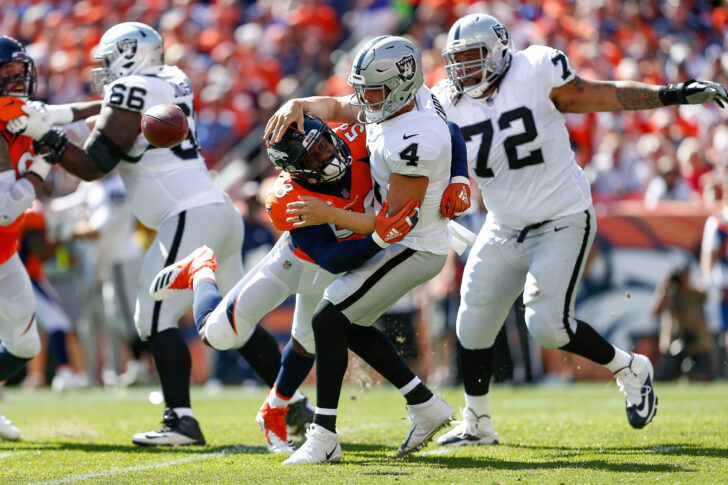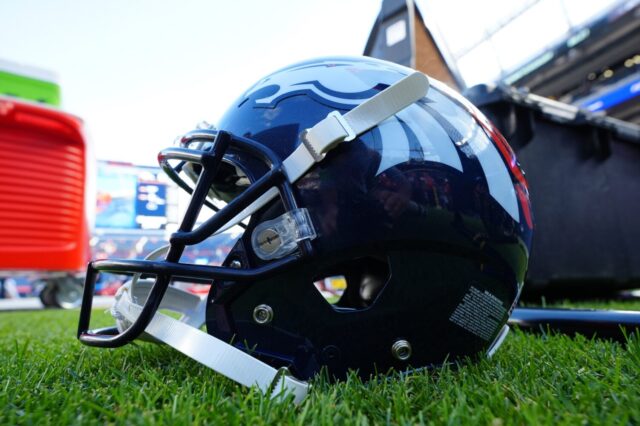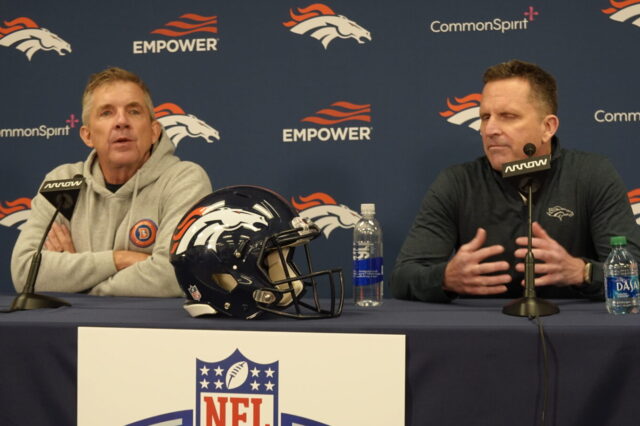We’re only three weeks into the season, and some positive trends are beginning to present themselves for the Denver Broncos.
What are those trends, and how could they potentially impact the upcoming matchup with the Las Vegas Raiders? Let’s look.
3.8: The number of points the Denver Broncos are allowing per half…
…Since their disastrous first half against the Seattle Seahawks.
This means, that over the last five halves, the Denver Broncos have been an out-of-this-world defense.
That lone half that started the season has been a severe outlier when compared to the other five halves of football that the Denver defense has played, and yet, the overall stats still look pretty dominant.
If you’re a fan of phonographs and the horse and buggy, you’ll be tickled pink to find that the Denver Broncos rank third in yards per game allowed (251.3), third in passing yards per game allowed(170.0), sixth in rushing yards per game allowed (81.3) and second in points per game allowed (12.0). If you’re more into Spotify and the automobile, you’ll be pleased to learn that the team ranks fifth in defensive DVOA, fourth in pass-defense DVOA, eighth in run-defense DVOA, and fifth in EPA/play.
All the metrics agree. This is an elite defense.
But, imagine what they would like if they didn’t have an outlying half serving as an intense negative, and sandbagging their season-long numbers. In that imagined reality, the Denver Broncos are on pace to be a legendary defense, reminiscent of what fans saw in 2015.
The team would be tied for first in yards per game allowed (214.0), first in passing yards per game allowed (138.4), third in rushing yards per game allowed (75.6) and first in points per game allowed (7.6). The 2015 Broncos finished at 283.1 yards (199.6 passing and 83.6 rushing) and 18.5 points allowed, on average, per game.
The advanced metrics are also hyping up the 2022 Denver Broncos in relation to the legendary unit of 2015. In the 2nd half of games, the 2022 Denver Broncos are posting a DVOA of -79.8% (2015 was -25.2%, so more than three times better) and an EPA/play of -0.441 (2015 was -0.119, so again, more than three times better).
Sample size and quality of competition do loom over all of this, but you can only play the teams on your schedule, and so far, this squad looks special.
BONUS STATS:
- The Denver Broncos are pressuring opposing quarterbacks on 29.52% of dropbacks, ranking seventh in the league. Pair that with a Raiders OL allowing pressure on 23.48% of dropbacks (17th-most in the league, good for the second-worst unit Denver has faced so far), and Carr should find himself under plenty of pressure.
- Through three weeks, Patrick Surtain II has allowed just 45 yards, the fourth-lowest total among cornerbacks in the league. He’s also allowing just 5.6 yards per reception (second-best), 3.2 yards per target (third-best), and 0.53 yards per snap (seventh-best). Since Week 2, he’s allowed a mere 10 yards (tied for second-best), at 5.0 yards per reception (tied for second-best), 1.13 yards per target (second-best) and 0.20 yards per snap (tied for second-best).
4,333: The number of days since Josh McDaniels last won a game as a head coach
Josh McDaniels hasn’t won a football game as a head coach since November 14th, 2010.
The Dreamworks animated film “Megamind” was the No. 1 movie in America, while the Denzel Washington and Chris Pine train drama “Unstoppable” was in the No. 2 position.
Ke$ha’s “We R Who We R” was the No. 1 song on the Billboard charts, with “Like A G6” from Far*East Movement nipping at its heels.
A story on the G.O.P. shifting their focus to 2012 after a dominant midterm election had just finished gracing the cover of the New York Times.
We’re talking a long time ago.
Over his last 25 games as a head coach, McDaniels boasts a record of 5-20 (.200). There are only eight coaches to have coached at least 25 games, and have career percentage worse than .200. Hue Jackson (.205), Gus Bradley (.226), Rod Marinelli (.208) and Pat Shurmur (.292) all have better career winning percentages as head coaches, than McDaniels does over his last 25 chances.
McDaniels should thank his preferred deity for gifting us with Urban Meyer, and his putrid .154 career winning percentage
2nd & 3rd: Courtland Sutton’s ranks in the advanced metrics Effective Receiving Yards and DVOA
It’s no secret that the Denver Broncos’ offense has been disappointing so far.
Injuries on the right side has led to the offensive line being less steady than expected, the running game has been good but unexceptional, the depth of weapons appears questionable, Russell Wilson doesn’t seem to be at the height of his powers, and the marriage between Wilson and Coach Hackett hasn’t gone perfectly so far.
One thing that is undeniably going right on offense though, is Courtland Sutton.
Sutton has re-emerged as the star receiver he was proving to be, back in 2019, as he currently ranks fifth in the NFL in receiving yards, with 291 receiving yards off 19 receptions.
Advanced analytics are even bolder about Sutton’s status as an elite receiver though.
Sutton currently ranks third in DVOA (35.6%) — a stat that attempts to measure how much value the individual player creates in comparison to an average player at the position on a per-play basis — and second in effective receiving yards — a stat that takes DVOA and extrapolates it over the number of attempts.
To over-simplify, DVOA demonstrates a player’s value, while effective yardage makes sure that the DVOA results aren’t being fluffed by a sample size.
Stefon Diggs is the only player that currently ranks ahead of Courtland Sutton in effective yardage.
Why should you take that stat serious, instead of writing it off as nerd gobbilty-gook?
2021’s top six in effective receiving yards: Cooper Kupp, Davante Adams, Justin Jefferson, Tyreek Hill and Stefon Diggs.
2020’s top five in effective receiving yards: Stefon Diggs, Davante Adams, Tyreek Hill, DeAndre Hopkins and Justin Jefferson.
There’s a proven track record here.



